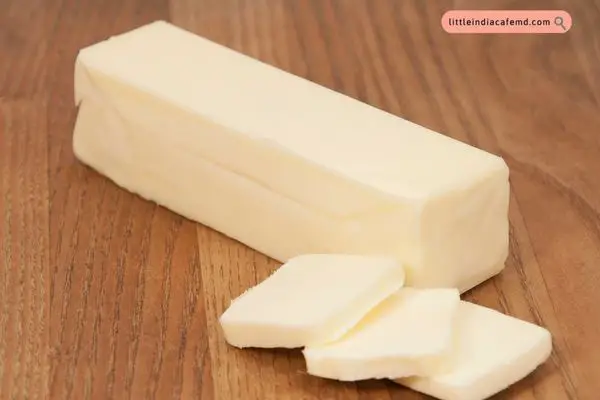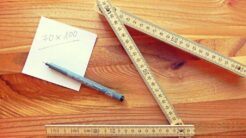Do you often find yourself in the kitchen, wondering about the measurement conversions for butter? Specifically, how many tablespoons are in a stick of butter? Don’t worry, we’ve got you covered. In this article, we’ll answer this common question and provide you with all the information you need to know about sticks of butter and their volume measurements. So grab your measuring cups and spoons, and let’s dive in!
Table of Contents
What is a Stick of Butter?

A stick of butter is a unit of measure typically used in baking. It equals ½ cup or 118ml. In the United States, butter is usually sold in packages of four sticks, with each stick weighing one ounce or 28 grams.
Butter is a dairy product made from the fat and protein found in milk. To make butter, cream is churned until it thickens and the fat globules clump together. The watery whey is then removed, leaving behind the solid butterfat.
Butter has a long and rich history, dating back to early civilizations. It was first mentioned in literature around 3,000 BC and was used by the ancient Greeks and Romans as both a food and a medicine. During the Middle Ages, butter was so valuable that it was used as currency.
Today, butter is an essential ingredient in a wide variety of recipes, ranging from sweet treats like cookies and cakes to savory dishes and sauces. It is also a popular spread for bread and other baked goods.
How Many Tablespoons in a Stick of Butter?

The answer is simple: there are 8 tablespoons in a stick of butter. So, if a recipe calls for one stick of butter, you can easily substitute it with eight tablespoons of butter.
It’s worth noting that the measurements may vary slightly depending on the type and brand of butter you are using. Some brands may sell slightly smaller sticks, which contain seven tablespoons instead of eight.
Converting Tablespoons to Sticks of Butter Chart
If you need to convert tablespoons of butter to sticks, you can refer to the following chart:
| Tablespoons | Sticks of Butter |
|---|---|
| 1 | 1/8 |
| 2 | 1/4 |
| 3 | 3/8 |
| 4 | 1/2 |
| 5 | 5/8 |
| 6 | 3/4 |
| 7 | 7/8 |
| 8 | 1 |
| … | … |
How Many Tablespoons in ⅓ Cup of Butter?
There are five tablespoons in ⅓ cup of butter, which is equivalent to 2.6 ounces or 74 grams. So, when a recipe calls for ⅓ cup of butter, you can use five tablespoons instead. Remember to adjust the measurements based on the type and brand of butter you are using.
How Can I Tell Where to Cut the Butter for ⅓ Cup?
The best way to determine where to cut the butter for ⅓ cup is by first weighing it. Place the butter on a kitchen scale and weigh it until you reach 2.6 ounces or 74 grams (equivalent to ⅓ cup). Then, using a ruler or measuring tape, measure out five tablespoons of butter (equivalent to ⅓ cup) and mark that point with a knife. Cut the butter at that mark, and you’ll have ⅓ cup of butter!
The Different Ways to Measure Butter
There are several ways to measure butter depending on your needs:
1. Use Sticks
Sticks of butter are the most common and widely used form for measuring butter. As mentioned earlier, one stick equals eight tablespoons or ½ cup (118ml).
2. Use Tablespoons
Tablespoons are convenient for measuring small amounts of butter. One tablespoon equals ½ fluid ounce or 14.8 milliliters.
3. Use Pounds
Pounds are used when a recipe calls for larger amounts of butter, such as for making cakes and pastries. One pound of butter is equal to two cups or 454 grams.
4. Use Cups
Cups are commonly used to measure larger amounts of butter. One cup of butter equals two sticks or 16 tablespoons, equivalent to 227 grams or 8 ounces.
5. Use the Metric System
In the metric system, one stick of butter equals 113 grams or 4 ounces. One tablespoon also equals 15 milliliters.
What is the Best Way to Measure Butter?
The best way to measure butter accurately is by using sticks, as it is the most standardized measurement tool. However, if you don’t have sticks on hand, you can use tablespoons or cups as an alternative. Remember to double-check the measurements of your ingredients before starting a recipe, as different butter brands may have slightly different measurements.
Tools for Precise Baking Measurements
If you want to achieve precise baking measurements, consider having the following tools in your kitchen:
- A digital kitchen scale for quick and accurate measurements of butter and other ingredients.
- Measuring spoons for measuring small amounts of butter precisely.
- A liquid measuring cup for measuring larger amounts of liquids like milk or cream.
- A measuring cup or spoon set with metric measurements for recipes that use the metric system.
- A kitchen thermometer to determine the exact temperature of butter when melted or softened.
- An offset spatula or butter knife for leveling off butter measurements and spreading it into baking pans.
- A metal spoon scraper to scrape out any remaining butter stuck in measuring cups or spoons.
How to Measure Butter?
To measure butter accurately, you have a few options depending on the form of butter and the ingredients you are using:
-
For solid butter in stick form, you can use a kitchen scale or a measuring cup. Cut the butter according to the required measurement indicated in your recipe. One stick of butter is typically equivalent to one tablespoon.
-
If your recipe calls for melted butter, use a liquid measuring cup. Fill the cup halfway with cold butter and microwave it until it’s melted. Keep an eye on the butter to prevent it from burning. Once melted, use the liquid measuring cup to measure the exact amount of butter required.
It’s important to note that some recipes specify the type of butter, such as unsalted or salted. Always check the label of each ingredient and adjust the salt measurements accordingly when making substitutions.
Tips for Measuring Butter Accurately
Here are some tips to ensure accurate measurements when working with butter:
-
Allow the butter to come to room temperature before measuring. It will be easier to measure when soft.
-
Use the markings on the butter wrapper as a guide for measuring sticks.
-
When using tablespoons, level off the top of the spoon with a knife or spatula for precise measurements.
-
Use a kitchen scale to measure pounds of butter accurately.
-
Always double-check your measurements before starting a recipe.
-
Store butter in a sealed container at room temperature or in the refrigerator.
-
Reserve any leftover butter for future use.
-
Clean up spills or drips immediately to avoid a sticky mess in your kitchen.
-
Use butter at the recommended temperature for the best results.
Keep in mind that different types of butter may have different consistencies, which can affect measurements and baking outcomes.
Common Recipes and Measurements for Butter
Here are some commonly used measurements for butter in recipes:
- 1 tablespoon of butter = 1/2 oz or 14.8ml
- 1 stick of butter (or ½ cup) = 8 tablespoons or 4 ounces or 113g
- 2 sticks of butter (or 1 cup) = 16 tablespoons or 8 ounces or 227g
- 3 sticks of butter (or 1½ cups) = 24 tablespoons or 12 ounces or 340g
- 4 sticks of butter (or 2 cups) = 32 tablespoons or 16 ounces or 454g
Other Measurement Conversions for Baking and Cooking
Here are some additional measurement conversions for common ingredients used in baking and cooking:
- 1 teaspoon = 4.9 milliliters
- 1 tablespoon = 14.8 milliliters
- 1 cup = 236.6 milliliters
- 1 pint = 473.2 milliliters
- 1 quart = 946.4 milliliters
- 1 gallon = 3785 milliliters
Measuring butter accurately is a valuable skill when it comes to baking various recipes. By using the right measurements and storing butter properly, you can ensure that your baked goods turn out perfectly every time. So, armed with this knowledge, have fun experimenting in the kitchen and enjoy your flavorful creations!
The Different Ways To Store Butter
The best way to store butter is in an airtight container or wrapped tightly in wax paper, foil, or plastic wrap. Keep it in the refrigerator and use it within a few weeks for optimal freshness. Butter can also be frozen for up to six months, but it’s best to use it within one month of freezing. For short-term storage, you can use a butter dish with a lid to prevent it from picking up odors from other foods.
When using butter from the refrigerator, let it sit at room temperature for about 10-15 minutes to soften. Cold butter doesn’t mix well into recipes and can affect the texture of baked goods. Allowing it to reach room temperature ensures that it’s ready for use.
When measuring cold butter, try to shape it evenly before cutting or measuring. Cold butter is more difficult to level off using a spoon or spatula, so do your best to ensure an even measurement.
In conclusion, knowing how to measure and store butter accurately is essential for achieving flavorful baked goods. By following these tips and measurements, you’ll become a master baker in no time!
References:


